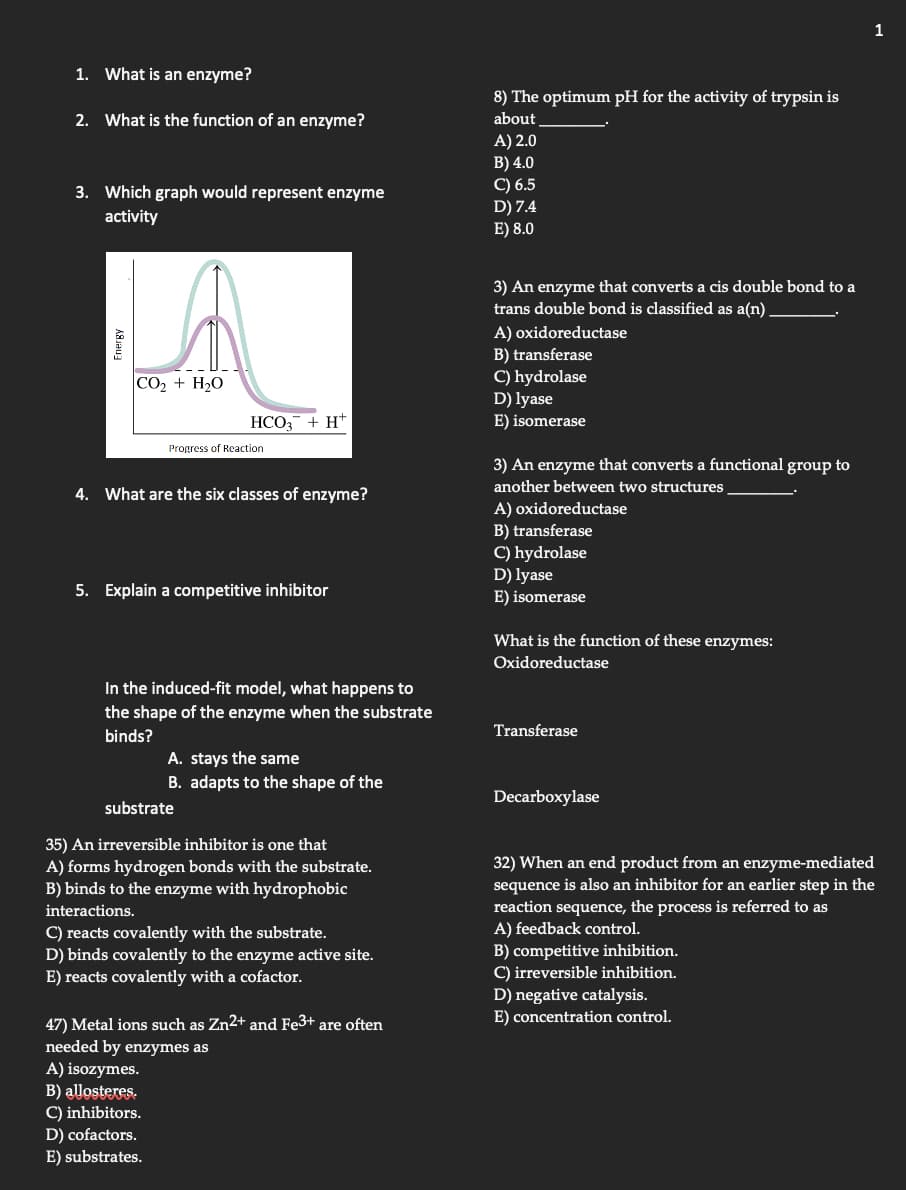1. What is an enzyme? 2. What is the function of an enzyme? 3. Which graph would represent enzyme activity Energy |CO2 + H,O HCO3 + H+ Progress of Reaction 4. What are the six classes of enzyme? 5. Explain a competitive inhibitor In the induced-fit model, what happens to the shape of the enzyme when the substrate binds? A. stays the same B. adapts to the shape of the substrate 5) An irreversible inhibitor is one that ) forms hydrogen bonds with the substrate. Obinds to the enzyme with hydrophobic teractions. ) reacts covalently with the substrate. ) binds covalently to the enzyme active site. reacts covalently with a cofactor. 7) Metal ions such as Zn²+ and Fe3+ are often eeded by enzymes as ) isozymes. allosteres. 8) The optimum pH for the activity of trypsin is about A) 2.0 B) 4.0 C) 6.5 D) 7.4 E) 8.0 3) An enzyme that converts a cis double bond to a trans double bond is classified as a(n). A) oxidoreductase B) transferase C) hydrolase D) lyase E) isomerase 3) An enzyme that converts a functional group to another between two structures A) oxidoreductase B) transferase C) hydrolase D) lyase E) isomerase What is the function of these enzymes: Oxidoreductase Transferase Decarboxylase 32) When an end product from an enzyme-mediated sequence is also an inhibitor for an earlier step in the reaction sequence, the process is referred to as A) feedback control. B) competitive inhibition. C) irreversible inhibition. D) negative catalysis. E) concentration control.
Neutral Amino Acids
Amino acids which do not have any charge on them are neutral amino acids.
Globular Protein
The globular proteins refer to the shape of protein specifically spherical in nature apart from spherical form fibrous, disordered and membrane-bound proteins exist. These globular proteins are miscible in water and form a colloidal solution rather than other types which might not exhibit solubility. Many classes of the fold are found in globular proteins, which render them a sphere shape. Globular fold containing proteins usually are referred to by the term globin.
Dimer
Dimers are basic organic compounds, which are derivates of oligomers. It is formed by the combination of two monomers which could potentially be strong or weak and in most cases covalent or intermolecular in nature. Identical monomers are called homodimer, the non-identical dimers are called heterodimer. The method by which dimers are formed is known as “dimerization”.
Dipeptide
A dipeptide is considered a mixture of two distinct amino acids. Since the amino acids are distinct, based on their composition, two dipeptide's isomers can be produced. Various dipeptides are biologically essential and are therefore crucial to industry.

Trending now
This is a popular solution!
Step by step
Solved in 3 steps









